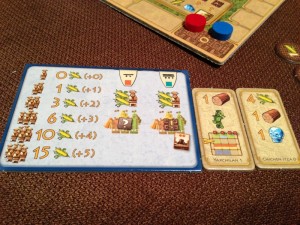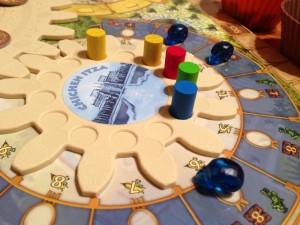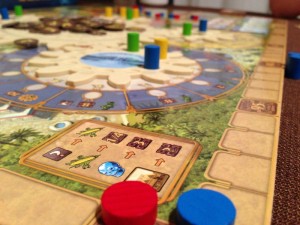 There is no shortage of worker placement games today. From the current reigning king of popularity, Agricola, to the relative newcomer Viticutlure (reviewed here), you have a lot options to place your gaming dollars (see what I did there?).
There is no shortage of worker placement games today. From the current reigning king of popularity, Agricola, to the relative newcomer Viticutlure (reviewed here), you have a lot options to place your gaming dollars (see what I did there?).
One of the big hyped games to come out of Essen last year was Tzolk’in: The Mayan Calendar. Tzolk’in is a worker placement game with a unique game component that’s sure to stop and get your attention. Tzolk’in features 5 interconnected gears that rotate throughout the game as the central component of its game play. Is Tzolk’in truly worthy of the hype it’s been getting or are the gears simply a big gimmick? Read on to find out!
Tzolk’in: The Mayan Calendar is a worker placement game for 2-4 players that plays in about 90 minutes. We’ve found that Tzolk’in will play well with any number of players but plays best with 4.
Game Overview:

In Tzolk’in, players take on the roles of different Mayan tribes. Players will be placing their workers on one of 5, interconnected gears that will rotate their workers to new spots as the game progresses. Unlike most worker placement games, player’s workers will take their actions when they are removed from the gears, not placed. Removing a worker will gather a player resources, allow them to construct buildings, advance on the temple tracks and research new technology. All of this is with the end goal of gaining the most victory points.
The game will last for one full revolution of the main, central gear. Once that gear returns to its home marker, the game ends and the player with the most victory points is the winner.
Game Components:
Tzolk’in gets some major style points for its components. The 5 gears that take up of the majority of the game board are both a fresh new concept and integrally tied to the game play. Less you think the gears are just a gimmick, they are vital to the game. Trying to keep track of the worker positions with tables or charts would have been a headache. The gears are both useful and fun to play with.
The rest of the components are about what you would expect from a quality euro game. There are a number of wooden tokens for each player, a well illustrated game board and tiles, and your standard resource cubes and cardboard tokens.
The game’s rulebook is very thorough and covers about everything you might want to know about how to play the game.
How To Play:

The actual game play in Tzolk’in is surprisingly easy for such a strategic game. The real challenge will come from the decisions you have to make during the game. Each player starts with a set of workers and some starting resources (randomly assigned based on a tile drawn). On a player’s turn they can take one of two actions:
1. Place Workers – A player can place any number of workers from their reserve on to one of the 5 gears. For each worker placed beyond the first, the player must spend a number of corn. Also, a player must place their worker on the lower spot on a gear. If that spot is occupied, they may place on a higher location, but must pay more corn for the privilege. A player may place as many or as few workers as they wish (up to their max available).
2. Retrieve Workers – If a player has no free workers to place (or just doesn’t want to place any) they may retrieve any or all of their workers from the gears. When a worker is retrieved, they take the action of whichever space their worker is currently on. Two of the wheels will provide resources to the player. Two of the other wheels will let players take actions, such as researching technology, construing buildings or getting more workers. The final wheel will help the player score more victory points and advance on the temple tracks.
After each player has taken their turn, the starting player spins the center wheel one “cog” clockwise. This will cause all the other wheels to rotate in turn. Any placed workers rotate with their gear, changing the location they are on. Player must plan carefully so they can retrieve their workers when they get to the appropriate location.
At four different spots on the center wheel (ever 1/4 full rotation), player must feed their workers corn. This can be assisted by certain buildings players can buy if they are lucky enough to be drawn in the building market. Once the wheel fully rotates back to its starting spot, the game ends and the player with the most victory points is the winner.

Game Experience:
While the rules for playing Tzolk’in are really easy to pick up, playing the actual game is not so simple. The fist hurdle a new player must overcome is to learn all the symbols on the board. Each stop on the 5 gears have a symbol that corresponds to a worker action. Some are pretty intuitive, like resources to be collected, but others will have players referencing the rule book for the first couple of games. The board is also somewhat intimidating for new players. The wheels will make sense pretty quickly, but then there is the building market, the technology trees and the temple tracks. Each of those sections are filled with symbols and spots for players to move around. This is a lot to take in all while a player is trying to wrap their head around planning their worker actions.

What I’m getting at here is Tzolk’in can be pretty unforgiving for new players. There is a whole lot going on and new players are going to be in an uphill battle. This is a game where an experienced player should almost always trounce a new player. Other than the building market, there is hardly any randomness in the game. Everything is all laid out in front of you (you even know almost precisely when the game will end), you just have to decide which path to take. For some people, who hate luck or randomness in a game, this will be a huge plus. Your turns will be all there in front of you and your careful planning (or lack thereof) will decide your fate. You can be as strategic as you want and nothing is there to stop you.
I think that’s also what makes Tzolk’in so loved. The fact that there are both a number of paths to victory and the lack of hidden information makes this a gem for a player that loves a deep, intense strategy game. Players will have to plan their moves several turns in advance. You have to know which wheel to put your worker on and calculate how many turns you have until you pull them off. The game has so many moving parts (pun intended) that players will be engaging in some tough mental math once they are working with a higher number of workers. This level of depth is going to appeal to a lot of players.
But on the other hand, there is not really any catch up mechanism in the game. The gears will continue their slow progression around as the turns roll by. If a new player messes up and makes some bad choices, they are going to have to live with their fate. Nothing in the game is going to help them overcome that. This can put a new player at a serious disadvantage vs an experienced player.

This also gets to my biggest gripe with the game. There is no wow moment in Tzolk’in. The turns will click by, workers will move on and off the gears, and players will adjust their various tracks. It’s calm, it’s stable, and turns will feel very even. Every turn you are moving workers on or off the gears at a stead pace. What I’m missing is the wow moment in a players turn. It’s that moment where you complete a really exciting turn and everyone stares in disbelief. It’s the moment in The Manhattan Project (review coming soon) where a player chains together 4 of his building actions to scrape together the necessary materials to build that big point bomb. Or it’s that moment in Viticulture (review here) where a player sneaks by the other players with a well times winter visitor card to fulfill that high VP wine order. Moments like that just won’t exist in Tzolk’in. Workers will trek around the gear until they are summoned home, bringing with them new resources to spend or upgrades on the other tracks. The calmness somehow fits with the depth of strategy and thinking required in the game, but I always like a bit more excitement in my games.
I’ve spent a good amount to time talking about issues with Tzolk’in, but I don’t want to give the impression that it’s a bad game, far from it. Tzolk’in is a really good game with a creative new mechanic. The strategy can run deep, really deep. I find myself working in big chunks of turns, planning out moves far in advance, and then planning what actions those moves will allow me to do. I also love all the different paths to victory I can take. I’ve played Tzolk’in quite a few times and rarely has any of the games played out the same. Tzolk’in will let you jump around the board, trying different strategies, and see which one works the best for you that particular game. Some games have a clear path to victory and it’s a race to see who can get there first, not so in Tzolk’in. This level of depth and strategy is going to appeal to a lot of people.
But it’s also not going to be for everyone and new players are going to have to be willing to put in the work to learn all the nuances of the game. As easy as the rules are to learn, the game reliance on symbols and lack of luck is going to present a hurdle for any new player to do well.
Final Thoughts:

In the end, I think Tzolk’in is a good game, just not an amazing one that the hype has been promising. To be honest, if it weren’t getting all the attention for the gears, I don’t think it would have been so high on everyone’s radar.
Tzolk’in does a lot of things right and is going to appeal to a lot of gamers. Anyone looking for a game that’s going to push your abilities to plan ahead is going to have a great time with Tzolk’in. There is a learning curve and Tzolk’in doesn’t tolerate too many mistakes by the player. Stumble and fall and you will be playing catchup the rest of the game. I should also note that player interaction in Tzolk’in will be minimal. Other than someone taking a building you wanted or a specific spot on the wheel, your turns will be fairly self contained. There just isn’t a whole lot in the game (action cards, special abilities, etc) that will interact with your fellow players.
At the end of the day, Tzolk’in: The Mayan Calendar is creative spike in a very crowded genre. I like Tzolk’in, I think it’s really well made, but I don’t think it’s going to push out some of my other current favorites in the worker placement genre. The lack of excitement and the learning curve for new players will, unfortunately, keep this from appearing on my gaming table as often as I hoped.
If the type of game sounds like appeals to you than it’s absolutely worth checking out Tzolk’in: The Mayan Calendar. Just go in with your eyes open of what the game is and don’t get distracted by the shiny gears, as cool as they are.
If you are interested in getting a copy for yourself, it’s about $40
Final Score: 3.5 Stars – A strong worker placement game with low luck but a good amount of “mental math” required.
 Hits:
Hits:
• Creative gear game component
• Low luck factor for those that desire that in a game
• Many paths to victory
Misses:
• No catchup game mechanic
• Low player interaction
• No “wow” moments in the game





















Good review! This is one of my Top 10 games of the year (so far).
This is a great review of a game I really, really enjoy (and I’m quite honored that you mentioned Viticulture several times in it). I particularly like how you mention that “wow” moment when everything comes together for a big moment in a game. I’ve never thought of it that way, but now I want to make sure all of my game designs have the potential to provide that moment.
That’s a great goal to have Jamey. Every game should have one of those moments. I do love playing Tzolk’in, but the game play is very even across the board.
It’s a great game, but there is no time to gather money, it is best if we run two rounds (spinning the time wheel twice, rather than once)